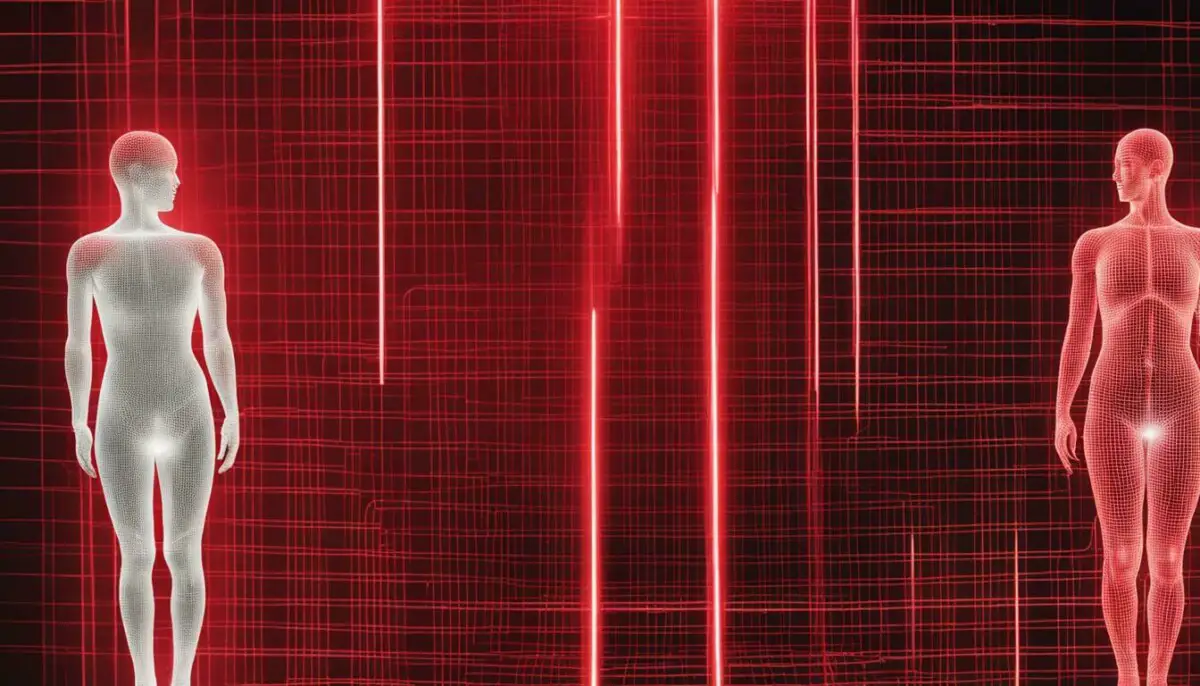Last Updated on 6 months by Francis
Welcome to our comprehensive guide to red light therapy and microcurrent therapy. These two therapies have gained popularity in recent years due to their numerous benefits and uses. While both therapies use low-level wavelengths to promote healing and wellness, they have distinct differences that make them suitable for different conditions and goals. In this article, we will explore the benefits, effectiveness, and differences between red light therapy and microcurrent therapy to help you make an informed decision about which therapy may be most beneficial for your needs.
Contents
Key Takeaways:
- Red light therapy and microcurrent therapy are two popular non-invasive therapies that use low-level wavelengths to promote healing and wellness.
- Red light therapy focuses on promoting skin health, hair growth, pain management, and overall well-being through collagen production and cellular function.
- Microcurrent therapy targets muscle stimulation and pain management, making it suitable for conditions such as injury recovery and anti-aging.
- Both red light therapy and microcurrent therapy have been found to be effective, but the specific applications may vary depending on the condition being treated.
- The choice between red light therapy and microcurrent therapy ultimately depends on your individual goals and needs. Consulting with a healthcare professional or qualified therapist can provide valuable guidance in making the right choice.
What is Red Light Therapy?
Red light therapy, also known as photobiomodulation (PBM), is a non-invasive, drug-free therapy that uses low-level red light wavelengths to stimulate the production of collagen, reduce inflammation, and improve cellular function. The use of red light therapy has gained popularity in recent years due to its numerous benefits for the skin, hair, and overall wellness.
Benefits of Red Light Therapy:
- Improves the appearance of skin tone and texture
- Reduces fine lines and wrinkles
- Stimulates hair growth and thickness
- Helps reduce acne and scarring
- Reduces inflammation and pain
Red light therapy works by using wavelengths of light to penetrate the skin and activate the body’s natural healing processes. The light energy is absorbed by the cells, promoting the production of ATP (Adenosine Triphosphate), which is the energy source for cells. This increased energy production helps cells perform their functions more efficiently, leading to benefits such as improved collagen production, reduced inflammation, and improved blood circulation.
| Red Light Therapy for Skin: | Red light therapy can be effective for a variety of skin conditions, including acne, rosacea, and hyperpigmentation. The therapy can also help reduce the appearance of fine lines and wrinkles, improving overall skin tone and texture. |
|---|---|
| Red Light Therapy for Hair Growth: | Red light therapy has been shown to stimulate hair growth and thickness by promoting blood circulation and cellular activity in hair follicles. |
| Red Light Therapy for Acne: | Red light therapy can help reduce acne and acne scarring by reducing inflammation and killing the bacteria that cause acne. |

Red light therapy is a safe and non-invasive treatment method that can be used in conjunction with other therapies or as a standalone treatment. It is becoming increasingly popular as a natural alternative to traditional skincare and hair growth treatments.
How Does Microcurrent Therapy Work?
Microcurrent therapy is a non-invasive treatment that uses low-level electrical currents to stimulate the muscles and tissues of the body. Through this stimulation, microcurrent therapy mimics the body’s natural electrical currents, promoting cell regeneration and tissue repair.
One of the advantages of microcurrent therapy is its suitability for pain management. It can help alleviate muscle and joint pain, aid in injury recovery, and reduce inflammation. Additionally, microcurrent therapy is commonly used for anti-aging treatments to improve skin tone and reduce wrinkles.
If you are considering microcurrent therapy for pain management, it is essential to work with a qualified therapist who can tailor the treatment to your specific needs. Advantages of microcurrent therapy include targeted muscle stimulation, faster healing, minimal side effects, and complementary use with other treatments.
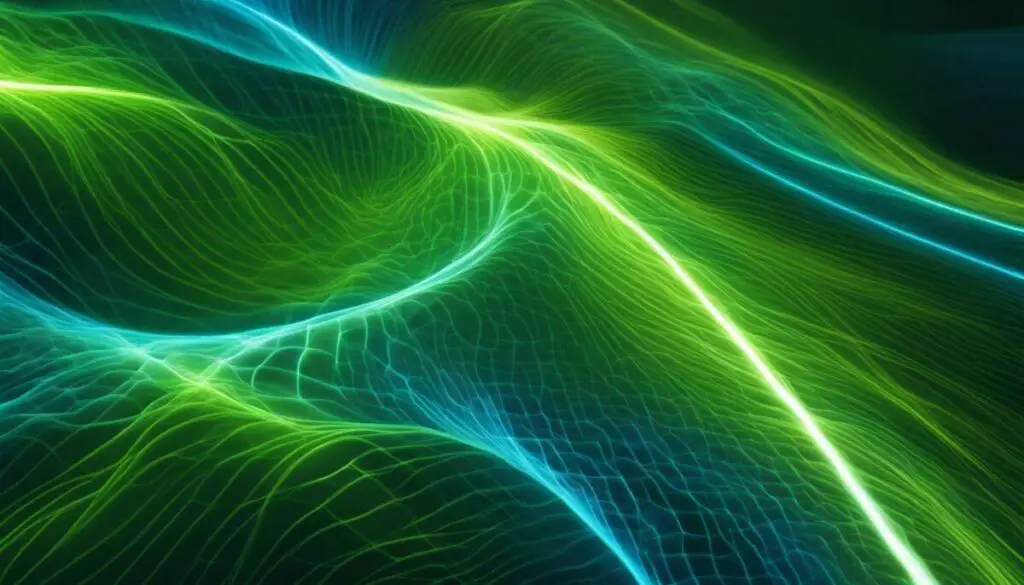
Microcurrent Therapy for Anti-Aging
Microcurrent therapy is also an effective treatment for reducing the signs of aging. Muscles in the face can be specifically targeted, promoting toning and reducing the appearance of wrinkles and fine lines. As microcurrent therapy improves skin tone and texture, it can help rejuvenate the skin naturally without the use of invasive procedures.
As with any treatment, it is important to consider the potential risks and contraindications before undergoing microcurrent therapy. Individuals with pacemakers or other implanted electronic devices should avoid microcurrent therapy, as it may interfere with their function. It is also essential to work with a qualified professional who can assess your individual needs and tailor the treatment accordingly.
Benefits of Red Light Therapy
Red light therapy has gained popularity in recent years due to its numerous health benefits. Here are some of the top benefits of red light therapy:
| Benefit | Description |
|---|---|
| Improved skin health | Red light therapy stimulates the production of collagen, reduces inflammation, and improves overall skin tone. It can also promote wound healing, reduce signs of aging, and treat acne. |
| Pain management | Red light therapy has been shown to reduce joint pain and muscle soreness, making it a useful tool for pain management. It may also help with conditions such as fibromyalgia and arthritis. |
| Enhanced athletic performance | Red light therapy can help increase blood flow and oxygenation to muscles, improve muscle recovery time, and reduce inflammation, thereby enhancing athletic performance and recovery. |
| Improved mood and mental health | Some research has suggested that red light therapy may help improve symptoms of depression and anxiety by increasing serotonin levels in the brain. |
If you are interested in any of these benefits, or simply looking for an effective and non-invasive therapy, red light therapy may be worth considering.

Advantages of Microcurrent Therapy
Microcurrent therapy offers many advantages that make it a popular treatment option for various conditions. One of the primary benefits of this therapy is that it is non-invasive, meaning that it does not require any incisions or injections. It is also drug-free, making it a safer alternative to medications that can have harmful side effects.
Another advantage of microcurrent therapy is that it provides targeted muscle stimulation. The low-level electrical currents used in this therapy can help activate and tone specific muscle groups, providing relief for a range of conditions, including pain management and muscle rehabilitation.
Microcurrent therapy can also promote faster healing. By mimicking the body’s natural electrical currents, it can help stimulate cell regeneration and tissue repair, leading to faster recovery times for injuries or surgeries.
Additionally, microcurrent therapy has minimal side effects, making it a suitable treatment option for individuals who may not tolerate medications well or are looking for a less invasive approach. It can also be used as a complementary therapy alongside other treatments, enhancing the benefits of other therapies.
Finally, microcurrent therapy is suitable for various conditions and can be used for both pain management and cosmetic purposes. Whether you are looking to alleviate muscle and joint pain or improve skin tone and reduce wrinkles, microcurrent therapy can offer targeted and effective results.

Effectiveness of Red Light Therapy vs Microcurrent Therapy
Both red light therapy and microcurrent therapy have been found to be effective in their respective applications. However, the effectiveness may vary depending on the specific condition being treated. Research studies, anecdotal evidence, and clinical trials can provide insights into the efficacy of these therapies for different purposes.
Red light therapy has been shown to be effective for wound healing, reducing inflammation, and improving skin health. It has also been found to be helpful for treating joint pain, enhancing athletic performance, and improving mood and mental health. While some studies have shown promising results for hair growth stimulation, more research is needed.
On the other hand, microcurrent therapy has been found to be effective for pain management, muscle rehabilitation, and anti-aging treatments. It can help reduce pain and inflammation, promote tissue regeneration, and improve skin tone and texture. Additionally, microcurrent therapy has been used as a complementary therapy alongside other treatments for various conditions.
When comparing the effectiveness of red light therapy vs microcurrent therapy, it is important to consider individual needs and goals. Both therapies offer unique benefits and can be effective for different purposes. Consulting with a healthcare professional or a qualified therapist can provide guidance in determining the best therapeutic approach for each individual.

It is worth noting that while red light therapy and microcurrent therapy have shown effectiveness separately, combining them may offer even greater benefits. The synergistic effects of these therapies can provide comprehensive and targeted results. However, it is important to consult with a qualified professional to determine the appropriate combination and treatment plan for specific needs.
Overall, both red light therapy and microcurrent therapy are effective options for various conditions and goals. By understanding their differences and effectiveness for specific purposes, individuals can make informed decisions about which therapy may be most beneficial for their needs.
Red Light Therapy vs Microcurrent: Skin Health
When it comes to improving skin health, both red light therapy and microcurrent therapy offer distinct benefits and approaches.
Red Light Therapy for Skin
Red light therapy has been shown to be effective in promoting collagen production and reducing inflammation, improving overall skin tone and texture. It can also provide benefits for specific conditions such as acne, wound healing, and reducing signs of aging.
One study found that red light therapy can significantly improve wrinkles, roughness, and collagen density in the skin when used consistently over several weeks.
Moreover, red light therapy can also be used to promote hair growth on the scalp, providing additional benefits for overall skin health and appearance.
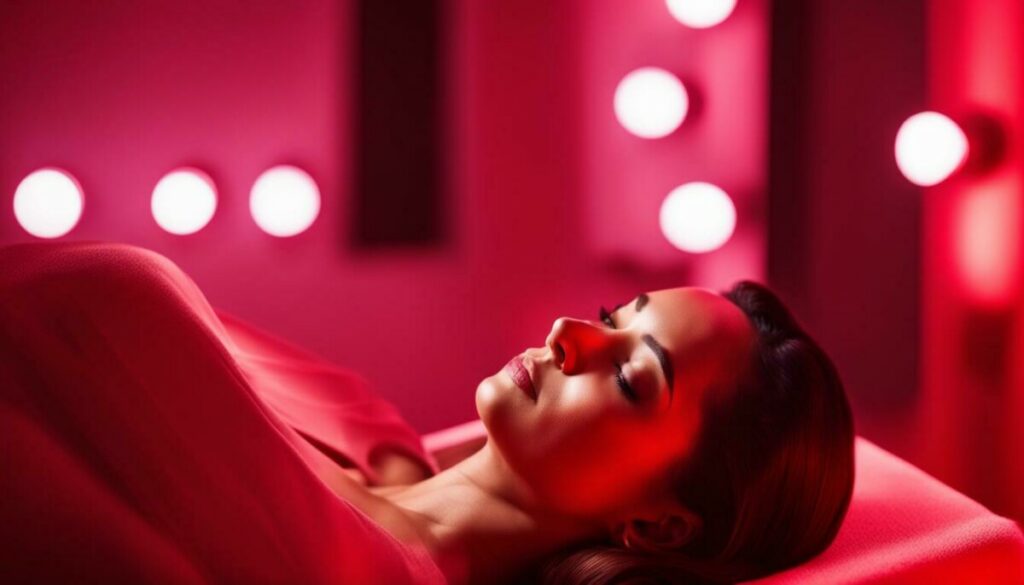
Microcurrent Therapy for Anti-Aging
Microcurrent therapy is a popular option for anti-aging treatments, targeting facial muscles to reduce wrinkles and improve skin tone. It works by promoting muscle stimulation and tissue repair, enhancing overall skin health with regular use.
A study conducted on microcurrent therapy for facial anti-aging found that it can significantly improve facial muscle toning, skin hydration, and overall appearance. Participants reported a reduction in fine lines and wrinkles, as well as a more youthful complexion.
However, it’s important to note that microcurrent therapy may not be effective for all types of skin concerns and may require regular maintenance to maintain results.
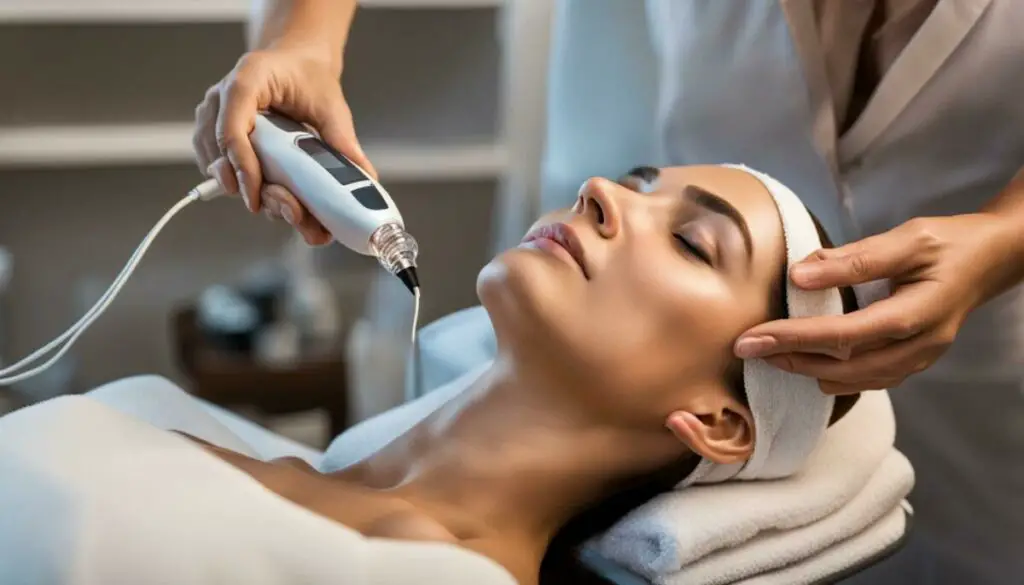
Overall, both red light therapy and microcurrent therapy can provide valuable benefits for skin health and anti-aging. Depending on your specific concerns and goals, one therapy may be more suitable for you than the other.
Red Light Therapy vs Microcurrent: Pain Management
Both red light therapy and microcurrent therapy have been found to provide pain relief, but they differ in how they target pain management. Microcurrent therapy is particularly effective for localized pain, aiding in muscle and joint pain and injury recovery. Microcurrent therapy has also been found to reduce inflammation, promoting faster healing.
Red light therapy, on the other hand, has broader applications for pain management, targeting a wide range of issues such as migraines, arthritis, and fibromyalgia. Red light therapy helps reduce inflammation while promoting circulation, which can help reduce joint pain, stiffness, and promote faster healing.
Combination therapy, using both red light and microcurrent therapy, can provide comprehensive pain management support, especially in chronic pain conditions. A study published in the Journal of Physical Therapy Science demonstrated that combination therapy helped reduce pain and improved physical function in patients with knee arthritis.
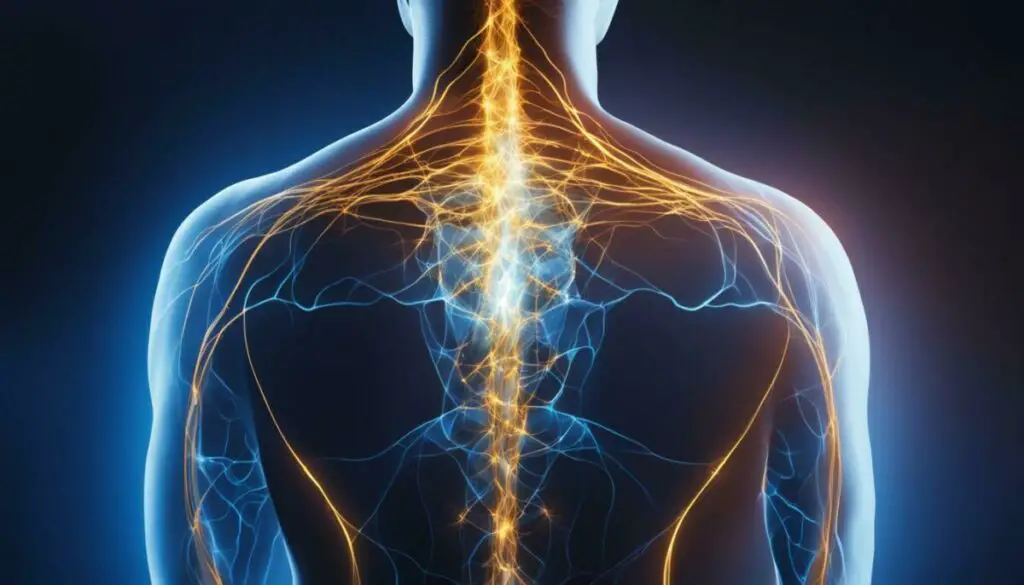
When considering red light therapy vs microcurrent therapy for pain management, it is important to consult with a healthcare professional or qualified therapist. They can help determine the most suitable therapy based on your individual goals and condition, taking into account any contraindications or restrictions.
Red Light Therapy vs Microcurrent: Hair Growth
Both red light therapy and microcurrent therapy have shown promise in promoting healthy hair growth. Red light therapy for hair growth has become increasingly popular in recent years, as studies have shown that low-level red light wavelengths can penetrate the scalp and stimulate hair follicles. This helps to improve circulation, reduce inflammation, and increase the production of cellular energy, all of which can contribute to healthier hair growth.
In contrast, microcurrent therapy does not directly target hair growth, but it can enhance overall scalp health and potentially support hair growth indirectly. By stimulating the muscles and tissues of the scalp, microcurrent therapy can improve blood flow and circulation, creating a more nourishing environment for hair follicles to grow.
| Red Light Therapy for Hair Growth | Microcurrent Therapy for Hair Growth |
|---|---|
| • Stimulates hair follicles | • Improves blood flow and circulation to the scalp |
| • Increases cellular energy production | • Enhances overall scalp health |
| • Reduces inflammation | • Can potentially support hair growth indirectly |
Overall, both red light therapy and microcurrent therapy can be effective tools in promoting hair growth. However, the specific therapy that is best suited for your needs may depend on various factors, such as the underlying cause of your hair loss, your overall health, and any contraindications or restrictions. Consulting with a qualified healthcare professional or therapist can provide valuable guidance on choosing the right therapy for you.

Red Light Therapy vs Microcurrent: Anti-Aging Effects
When it comes to anti-aging, both red light therapy and microcurrent therapy offer unique benefits. Microcurrent therapy is commonly used for facial muscles’ toning, tightening the skin, and reducing wrinkles and fine lines. This therapy delivers low-level electrical current to the facial muscles, promoting regeneration and tissue repair, which can lead to a firmer, more youthful appearance.
The combination of microcurrent therapy with red light therapy can enhance anti-aging benefits. Red light therapy stimulates collagen production, reduces inflammation, and improves skin tone and texture. By promoting cellular function and circulation, it can also have an indirect effect on reducing wrinkles and sagging skin.
It is essential to note that the effectiveness of these therapies may vary depending on individual factors such as age, skin type, and overall health. Consulting with a qualified professional can help determine the right therapeutic approach to achieve your desired anti-aging outcomes.

Differences Between Red Light Therapy and Microcurrent Therapy
While red light therapy and microcurrent therapy share some similarities in terms of their non-invasive and low-risk approaches, there are fundamental differences between the two.
Red light therapy primarily works on a cellular level, using low-level red light wavelengths to stimulate the production of collagen, reduce inflammation, and improve cellular function. As a result, it can provide a range of benefits such as wound healing, reducing signs of aging, and acne treatment, among others. Red light therapy can also stimulate hair growth on the scalp.
On the other hand, microcurrent therapy uses low-level electrical currents to stimulate the muscles and tissues of the body. By mimicking the body’s natural electrical currents, it promotes cell regeneration, tissue repair, and muscle rehabilitation. Microcurrent therapy is commonly used for pain management, muscle rehabilitation, and anti-aging treatments to improve skin tone and reduce wrinkles.
Therefore, while red light therapy is more focused on skin health, hair growth, and cellular function, microcurrent therapy is more targeted towards muscle stimulation, pain management, and anti-aging.
| Red Light Therapy | Microcurrent Therapy |
|---|---|
| Works on a cellular level | Stimulates muscles and tissues |
| Primarily focuses on skin health and hair growth | Targeted towards pain management, muscle rehabilitation, and anti-aging |
| Uses low-level red light wavelengths | Uses low-level electrical currents |
“While red light therapy offers several benefits for skin health, promoting cellular function, and stimulating hair growth, microcurrent therapy is more targeted towards muscle stimulation, pain management, and anti-aging.”
Understanding the differences between these two therapies will help you make an informed decision about which one is most suitable for your needs. However, you can consult with a healthcare professional or a qualified therapist to get a better understanding of which therapy aligns with your goals.

Choosing Between Red Light Therapy and Microcurrent Therapy
The decision to choose between red light therapy and microcurrent therapy can be a daunting task, especially if you are new to these therapies. However, understanding the differences between these two forms of therapy will help you make an informed decision.
Red light therapy primarily focuses on skin health and mitochondrial function. It uses low-level wavelengths of light to penetrate the skin and promote natural healing processes. The benefits of red light therapy include reducing inflammation, accelerating wound healing, improving hair growth, and enhancing overall well-being.
Microcurrent therapy involves the application of low-level electrical currents to specific areas of the body. It targets muscle stimulation and tissue repair, making it an effective treatment for pain management, muscle rehabilitation, and anti-aging therapies. Microcurrent therapy can also improve the appearance of skin by toning facial muscles, reducing fine lines, and promoting cell regeneration.
When choosing between the two therapies, consider your specific needs and goals. If you are primarily interested in improving skin health, promoting hair growth, or enhancing overall well-being, red light therapy may be the better option. However, if you are looking for pain management, muscle rehabilitation, or anti-aging therapies, microcurrent therapy may be more suitable.
It is essential to consult with a healthcare professional or trained therapist before undergoing any therapy. They can help you determine which therapy is right for your specific needs and provide guidance on how to use it safely and effectively.

Exploring Combination Therapy Options
While both red light therapy and microcurrent therapy have their unique benefits and applications, combining them may provide even more significant benefits for certain conditions or goals. Known as combination therapy, this approach involves using two or more therapies simultaneously or sequentially to enhance their effects.
For instance, combining red light therapy and microcurrent therapy for skin rejuvenation can provide a comprehensive treatment that targets both the muscles and cells of the face, improving skin tone, texture, and elasticity.
Similarly, combining these therapies for pain management can provide more targeted relief, as microcurrent therapy can help alleviate muscle and joint pain, while red light therapy can reduce inflammation and promote overall healing.
However, it is important to note that combination therapy may not be appropriate or effective for all conditions or individuals. The specific combination and treatment plan should be determined by a qualified professional based on the individual’s needs, goals, and medical history.
Overall, combining red light therapy and microcurrent therapy can be a powerful tool for achieving a variety of health and wellness goals. By exploring combination therapy options, you can potentially enhance the benefits of each therapy and tailor your treatment to your specific needs.

Considering Safety and Precautions
Both red light therapy and microcurrent therapy are generally safe and well-tolerated. However, it is crucial to follow safety guidelines and precautions recommended by professionals or manufacturers to avoid any adverse effects.
Red Light Therapy Safety
Red light therapy is considered safe for most people. However, it is essential to wear eye protection during the treatment to avoid any damage to the retina. Additionally, individuals with a history of skin cancer, photosensitivity, or taking medications that increase sensitivity to light should avoid red light therapy.
Microcurrent Therapy Safety
Microcurrent therapy is generally safe, but there may be some contraindications for certain individuals. Those with pacemakers, epilepsy, pregnancy, or open wounds should avoid microcurrent therapy. It is also important to ensure that all electrodes are placed correctly and that the current is not too high, which can cause skin irritation or burns.
Consult with a qualified healthcare professional or therapist before undergoing any red light therapy or microcurrent therapy. Inform your provider about any medical conditions, allergies, or medications that may affect the treatment’s safety and effectiveness.

Conclusion
Red light therapy and microcurrent therapy provide unique benefits and have their individual applications. By understanding the differences between the two, you can determine which therapy is most suitable for your specific needs. Whether you’re seeking to improve skin health, manage pain, or promote hair growth, both therapies can be valuable tools in your wellness journey.
It is important to conduct thorough research and consult with professionals before undergoing any therapy. This will allow you to make an informed decision and ensure the safety and effectiveness of your treatment plan.
In some cases, combining red light therapy and microcurrent therapy may provide enhanced results. However, it’s crucial to seek guidance from a qualified professional to determine the appropriate treatment plan for your specific needs and goals.
Remember to follow safety guidelines and precautions recommended by professionals or manufacturers. Certain individuals may need to exercise caution or seek medical advice before undergoing these therapies, such as pregnant women, people with certain medical conditions, or those using certain medications.
Overall, whether you choose red light therapy, microcurrent therapy, or a combination of both, these therapies can offer comprehensive and targeted results, improving your overall well-being and quality of life.
FAQ
What is the difference between red light therapy and microcurrent therapy?
Red light therapy uses low-level red light wavelengths to stimulate collagen production and improve cellular function, while microcurrent therapy involves low-level electrical currents to stimulate muscles and tissues.
What are the benefits of red light therapy?
Red light therapy offers numerous benefits, including improved skin health, reduced joint pain, enhanced athletic performance, and improved mood and mental health.
What are the advantages of microcurrent therapy?
Microcurrent therapy is non-invasive, provides targeted muscle stimulation, promotes faster healing, and has minimal side effects. It can be used for pain management, injury recovery, and cosmetic purposes.
How effective are red light therapy and microcurrent therapy?
Both therapies have been found to be effective, but the effectiveness may vary depending on the specific condition being treated. Further research and clinical trials can provide more insights into their efficacy.
How does red light therapy benefit the skin?
Red light therapy promotes collagen production, reduces inflammation, and improves overall skin tone. It can also promote wound healing, reduce signs of aging, and treat acne.
How does microcurrent therapy work for pain management?
Microcurrent therapy stimulates muscles and tissues with low-level electrical currents, promoting cell regeneration and tissue repair. It is effective for localized pain management, muscle rehabilitation, and reducing inflammation.
Can red light therapy stimulate hair growth?
Red light therapy has shown promise in promoting hair growth by stimulating hair follicles and improving blood circulation to the scalp.
How does microcurrent therapy help with anti-aging?
Microcurrent therapy tightens and tones facial muscles, reducing the appearance of wrinkles and sagging skin, thus helping with anti-aging effects.
What are the main differences between red light therapy and microcurrent therapy?
Red light therapy primarily focuses on promoting cellular function and skin health, while microcurrent therapy targets muscle stimulation and pain management.
How do I choose between red light therapy and microcurrent therapy?
The choice depends on your specific goals and needs. Consider factors such as the condition you want to address, desired outcomes, and any contraindications or restrictions. Consulting with a healthcare professional or therapist can provide guidance.
Can red light therapy and microcurrent therapy be combined?
Yes, in some cases, combining red light therapy and microcurrent therapy may offer enhanced benefits. Consult with a professional to determine the appropriate combination and treatment plan.
Are red light therapy and microcurrent therapy safe?
Both therapies are generally considered safe, but it’s important to follow safety guidelines and precautions. Pregnant women, individuals with certain medical conditions, or those on specific medications should exercise caution or seek medical advice.

